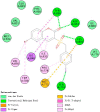Design, Synthesis and Preliminary Biological Evaluation of Benzylsulfone Coumarin Derivatives as Anti-Cancer Agents
- PMID: 31703373
- PMCID: PMC6891324
- DOI: 10.3390/molecules24224034
Design, Synthesis and Preliminary Biological Evaluation of Benzylsulfone Coumarin Derivatives as Anti-Cancer Agents
Abstract
In this work, a series of benzylsulfone coumarin derivatives 5a-5o were synthesized and characterized. Kinase inhibitory activity assay indicated that most of the compounds showed considerable activity against PI3K. Anti-tumor activity studies of the active compounds were also carried out in vitro on the Hela, HepG2, H1299, HCT-116, and MCF-7 tumor cell lines by MTS assay. The structure-activity relationships (SARs) of these compounds were analyzed in detail. Compound 5h exhibited the most potent activities against the mentioned cell lines with IC50 values ranging from 18.12 to 32.60 μM, followed by 5m with IC50 values of 29.30-42.14 μM. Furthermore, 5h and 5m clearly retarded the migration of Hela cells in vitro. Next, an in silico molecular docking study was conducted to evaluate the binding models of 5h and 5m towards PI3Kα and PI3Kβ. Collectively, the above findings suggested that compounds 5h and 5m might be promising PI3K inhibitors deserving further investigation for cancer treatment.
Keywords: anticancer; benzylsulfone; cell migration; coumarins; molecular docking; phosphoinositide 3-kinase (PI3K).
Conflict of interest statement
The authors declare no conflict of interest.
Figures










Similar articles
-
Synthesis and Structure-Activity Relationships of 4-Morpholino-7,8-Dihydro-5H-Thiopyrano[4,3-d]pyrimidine Derivatives Bearing Pyrazoline Scaffold.Molecules. 2017 Oct 31;22(11):1870. doi: 10.3390/molecules22111870. Molecules. 2017. PMID: 29088090 Free PMC article.
-
Design, Synthesis, In Vitro Anti-cancer Activity, ADMET Profile and Molecular Docking of Novel Triazolo[3,4-a]phthalazine Derivatives Targeting VEGFR-2 Enzyme.Anticancer Agents Med Chem. 2018;18(8):1184-1196. doi: 10.2174/1871520618666180412123833. Anticancer Agents Med Chem. 2018. PMID: 29651967
-
Eco-friendly synthesis of novel cyanopyridine derivatives and their anticancer and PIM-1 kinase inhibitory activities.Eur J Med Chem. 2017 Jul 7;134:357-365. doi: 10.1016/j.ejmech.2017.04.024. Epub 2017 Apr 14. Eur J Med Chem. 2017. PMID: 28431341
-
Design and Synthesis of Coumarin Derivatives as Novel PI3K Inhibitors.Anticancer Agents Med Chem. 2017;17(3):395-403. doi: 10.2174/1871520616666160223120207. Anticancer Agents Med Chem. 2017. PMID: 26902599
-
Therapeutic Effects of Coumarins with Different Substitution Patterns.Molecules. 2023 Mar 6;28(5):2413. doi: 10.3390/molecules28052413. Molecules. 2023. PMID: 36903660 Free PMC article. Review.
Cited by
-
A comprehensive review on the potential of coumarin and related derivatives as multi-target therapeutic agents in the management of gynecological cancers.Front Pharmacol. 2024 Sep 16;15:1423480. doi: 10.3389/fphar.2024.1423480. eCollection 2024. Front Pharmacol. 2024. PMID: 39364049 Free PMC article. Review.
-
Dual PI3K/Akt Inhibitors Bearing Coumarin-Thiazolidine Pharmacophores as Potential Apoptosis Inducers in MCF-7 Cells.Pharmaceuticals (Basel). 2022 Mar 31;15(4):428. doi: 10.3390/ph15040428. Pharmaceuticals (Basel). 2022. PMID: 35455425 Free PMC article.
-
Insights on Stability Constants and Structures of Complexes between Coumarin Derivatives and Pb(II) in Aqueous Media.Molecules. 2024 Apr 23;29(9):1911. doi: 10.3390/molecules29091911. Molecules. 2024. PMID: 38731402 Free PMC article.
-
Coumarins in Anticancer Therapy: Mechanisms of Action, Potential Applications and Research Perspectives.Pharmaceutics. 2025 May 1;17(5):595. doi: 10.3390/pharmaceutics17050595. Pharmaceutics. 2025. PMID: 40430886 Free PMC article. Review.
-
Targeting Solid Tumors With BTK Inhibitors.Front Cell Dev Biol. 2021 Apr 14;9:650414. doi: 10.3389/fcell.2021.650414. eCollection 2021. Front Cell Dev Biol. 2021. PMID: 33937249 Free PMC article.
References
MeSH terms
Substances
Grants and funding
LinkOut - more resources
Full Text Sources
Miscellaneous

